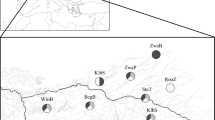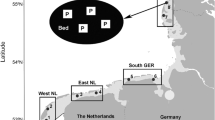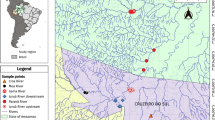Abstract
The impact of parasites on host population dynamics depends on local abundance of the parasites, which may vary considerably across spatial scales. In sand hopper populations, mermithid parasites have major impacts on host dynamics, which may vary among spatially separated populations due to the sand hopper’s wide, patchy distribution. The present study compared the abundance and biomass of a mermithid parasite (Thaumamermis zealandica Poinar et al., 2002) in sand hoppers (Bellorchestia quoyana (Milne-Edwards)) both within and among disconnected beaches. In addition, several variables were measured and tested as potentially important predictors of the parasite abundance and biomass. It was found that geographic isolation may only be responsible for minor differences in parasite populations compared with other factors. Host size was identified as the most important predictor of mermithid parasite abundance, but epibiont abundance, kelp patch mass and host density were poor predictors of abundance. These factors were also poor predictors of parasite biomass in hosts. This study further supports the notion that studies aiming to elucidate population dynamics or patterns should sample thoroughly across both spatial and temporal scales.

Similar content being viewed by others
References
Anderson RM (1979) Parasite pathogenicity and the depression of host population equilibria. Nature 279:150–152
Anderson D (2008) Model based inference in the life sciences: a primer on evidence. Springer, Dordrecht, p 184
Arneberg P, Skorping A, Grenfell B, Read A (1998) Host densities as determinants of abundance in parasite communities. Proc R Soc Lond Biol 265:1283–1289
Barton K (2013) Package ‘MuMIn’. http://cran.rproject.org/web/packages/MuMIn/MuMIn.pdf. Accessed 20 July 2014.
Bates AE, Poulin R, Lamare MD (2010) Spatial variation in parasite induced mortality in an amphipod: shore height versus exposure history. Oecologia 163:651–659
Bolker B, Skaug H, Magnusson A, Nielsen A (2012) Getting started with the glmmADMB package. http://glmmadmb.r-forge.rproject.org/glmmADMB.pdf. Accessed 20 July 2014.
Brown A (2001) Biology of sandy beaches. In: Steele J, Thorpe S, Turekian K (eds) Encyclopedia of ocean sciences. Elsevier, Amsterdam, pp 2496–2504
Currey RJ, Poulin R (2006) Do parasites affect burrowing depth and habitat choice of sand hoppers, Talorchestia quoyana (Amphipoda: Talitridae)? N Z J Mar Freshw 40:509–518
Currey RJ, Poulin R (2007) Do parasites affect burrowing activity and emergence of sand hoppers, Talorchestia quoyana (Amphipoda: Talitridae)? Can J Zool 85:344–351
Dogiel VA, Petrushevski GK, Polyanski YI (1958) Parasitology of fishes. Oliver and Boyd, London, Translated from Russian by Kabata Z, 1961
Dufour C, Probert P, Savage C (2012) Macrofaunal colonisation of stranded Durvillaea antarctica on a southern New Zealand exposed sandy beach. N Z J Mar Freshw 46:369–383
Ebert D, Lipsitch M, Mangin KL (2000) The effect of parasites on host population density and extinction: experimental epidemiology with Daphnia and six microparasites. Am Nat 156:459–477
Fanini L, Lowry J (2014) Coastal talitrids and connectivity between beaches: a behavioural test. J Exp Mar Biol Ecol 457:120–127
George-Nascimento M, Garcias F, Munoz G (2002) Parasite body volume and infracommunity patterns in the southern pomfret Brama australis (Pisces: Bramidae). Rev Chil Hist Nat 75:835–839
George‐Nascimento M, Munoz G, Marquet PA, Poulin R (2004) Testing the energetic equivalence rule with helminth endoparasites of vertebrates. Ecol Lett 7:527–531
Inglis G (1989) The colonisation and degradation of stranded Macrocystis pyrifera by the macrofauna of a New Zealand sandy beach. J Exp Mar Biol Ecol 125:203–217
Lafferty KD (2004) Fishing for lobsters indirectly increases epidemics in sea urchins. Ecol Appl 14:1566–1573
Lohse K, Gutierrez A, Kaltz O (2006) Experimental evolution of resistance in Paramecium caudatum against the bacterial parasite Holospora undulata. Evolution 60:1177–1186
Marsden I (1991) Kelp-sandhopper interactions on a sand beach in New Zealand. II. Population dynamics of Talorchestia quoyana (Milne-Edwards). J Exp Mar Biol Ecol 152:75–90
Morand S, Legendre P, Gardner SL, Hugot JP (1996) Body size evolution of oxyurid (Nematoda) parasites: the role of hosts. Oecologia 107:274–282
Morton J, Miller M (1973) The New Zealand sea shore, 2nd edn. Collins, London
Poinar G, Latham A, Poulin R (2002) Thaumamermis zealandica n. sp. (Mermithidae: Nematoda) parasitizing the intertidal marine amphipod Talorchestia quoyana (Talitridae: Amphipoda) in New Zealand, with a summary of mermithids infecting amphipods. Syst Parasitol 53:227–233
Poulin R (1996) The evolution of body size in the Monogenea: the role of host size and latitude. Can J Zool 74:726–732
Poulin R (2007) Are there general laws in parasite ecology? Parasitology 134:763–776
Poulin R, Latham D (2002) Parasitism and the burrowing depth of the beach hopper Talorchestia quoyana (Amphipoda: Talitridae). Anim Behav 63:269–275
Poulin R, Rate S (2001) Small-scale spatial heterogeneity in infection levels by symbionts of the amphipod Talorchestia quoyana (Talitridae). Mar Ecol Prog Ser 212:211–216
R Development Core Team (2008) R: a language and environment for statistical computing. R Foundation for Statistical Computing, Vienna, Austria. ISBN 3-900051-07-0. http://www.R-project.org.
Thieltges DW, Fredensborg BL, Poulin R (2009) Geographical variation in metacercarial infection levels in marine invertebrate hosts: parasite species character versus local factors. Mar Biol 156:983–990
Webster JP, Gower CM, Blair L (2004) Do hosts and parasites coevolve? Empirical support from the Schistosoma system. Am Nat 164:S33–S51
Acknowledgments
We thank the evolutionary and ecological parasitology research group of the University of Otago for their comments on the earlier draft of this paper. This study was supported by funding from the Division of Sciences through a summer bursary to TKR, University of Otago, New Zealand.
Author information
Authors and Affiliations
Corresponding author
Rights and permissions
About this article
Cite this article
Rasmussen, T.K., Randhawa, H.S. Factors influencing spatial variation and abundance of a mermithid parasite in sand hoppers. Parasitol Res 114, 895–901 (2015). https://doi.org/10.1007/s00436-014-4254-5
Received:
Accepted:
Published:
Issue Date:
DOI: https://doi.org/10.1007/s00436-014-4254-5




